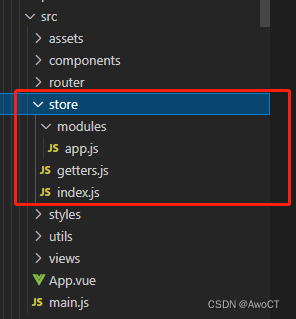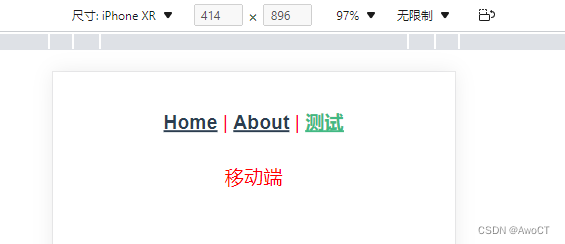vue开发项目(PC端和移动端共用一套代码)(二)
vue开发PC端和移动端共用一套代码,通过屏幕宽度大小来判断显示pc端样式还是移动端样式。
在 https://blog.csdn.net/qq_39480297/article/details/125785301?spm=1001.2014.3001.5501一文中,采用路由控制,加载PC端代码还是移动端代码。本文采用,通过屏幕宽度大小来判断加载相应端的代码。
1、必备条件
首先,创建一个新的vue项目。
2、配置
2.1、创建新的界面
① 创建 src/views/index/index.vue
② 在src/router/index.js中设置
const routes = [
{
path: '/',
name: 'Home',
component: Home
},
{
path: '/about',
name: 'About',
// route level code-splitting
// this generates a separate chunk (about.[hash].js) for this route
// which is lazy-loaded when the route is visited.
component: () => import(/* webpackChunkName: "about" */ '../views/About.vue')
}, {
path: '/index',
name: 'Index',
component: () =>
import(/* webpackChunkName: "about" */ '../views/index')
}
]③ 在App.vue中设置
<template>
<div id="app" :class="[device]">
<div id="nav">
<router-link to="/">Home</router-link> |
<router-link to="/about">About</router-link> |
<router-link to="/index">测试</router-link>
</div>
<router-view/>
</div>
</template>2.1、适配
① src/views/index/路径下,创建pc/index.vue、m/index.vue

② 设置store,在src/store中,目录如下:

index.js
import Vue from 'vue'
import Vuex from 'vuex'
import getters from './getters'
Vue.use(Vuex)
const modulesFiles = require.context('./modules', true, /\.js$/)
// you do not need `import app from './modules/app'`
// it will auto require all vuex module from modules file
const modules = modulesFiles.keys().reduce((modules, modulePath) => {
// set './app.js' => 'app'
const moduleName = modulePath.replace(/^\.\/(.*)\.\w+$/, '$1')
const value = modulesFiles(modulePath)
modules[moduleName] = value.default
return modules
}, {})
const store = new Vuex.Store({
modules,
getters
})
export default storeapp.js
const state = {
device: 'pc' // 默认是PC端,====》 PC端:pc、移动端:m
}
const mutations = {
SET_DEVICE: (state, device) => {
state.device = device
}
}
const actions = {
setDevice ({ commit }, device) {
commit('SET_DEVICE', device)
}
}
export default {
namespaced: true,
state,
mutations,
actions
}
getters.js
const getters = {
device: state => state.app.device
}
export default getters③ 在src/views/index/index.vue中,通过判断store中的device,选择加载pc或m。
<template>
<div>
<mobile v-if="device == 'm'" />
<pc v-if="device == 'pc'"/>
</div>
</template>
<script>
import { mapGetters } from 'vuex'
import pc from './pc'
import mobile from './m'
export default {
components: {
pc,
mobile
},
data () {
return {}
},
computed: {
...mapGetters(['device'])
}
}
</script>④ 在App.vue中,通过检测屏幕变化,设置当前设备应采用pc端还是移动端。
<template>
<div id="app">
<div id="nav">
<router-link to="/">Home</router-link> |
<router-link to="/about">About</router-link> |
<router-link to="/index">测试</router-link>
</div>
<router-view/>
</div>
</template>
<script>
import { mapGetters } from 'vuex'
import { throttle } from '@/utils'
export default {
computed: {
...mapGetters(['device'])
},
created () {
// resize节流
this.resizeChange = throttle(this.resizeChange, 200)
this.resizeChange()
window.addEventListener('resize', this.resizeChange, false)
},
methods: {
resizeChange () {
console.log(document.documentElement.clientWidth)
if (document.documentElement.clientWidth > 1000) { // 默认设置当屏幕宽度 > 1000 时,为PC端
this.$store.dispatch('app/setDevice', 'pc')
} else { // 默认设置当屏幕宽度 <= 1000 时,为移动端
this.$store.dispatch('app/setDevice', 'm')
}
}
},
destroyed () {
window.removeEventListener('resize', this.resizeChange, false)
}
}
</script>上述代码中,throttle节流方法,可以使用框架,也可以自定义,本文中使用自定义,在src/utils/index.js中,添加
export function throttle (func, wait, options) {
let context
let args
let result
var timeout = null
var previous = 0
if (!options) options = {}
var later = function () {
previous = options.leading === false ? 0 : new Date().getTime()
timeout = null
result = func.apply(context, args)
if (!timeout) context = args = null
}
return function () {
var now = new Date().getTime()
if (!previous && options.leading === false) previous = now
var remaining = wait - (now - previous)
context = this
args = arguments
if (remaining <= 0 || remaining > wait) {
if (timeout) {
clearTimeout(timeout)
timeout = null
}
previous = now
result = func.apply(context, args)
if (!timeout) context = args = null
} else if (!timeout && options.trailing !== false) {
timeout = setTimeout(later, remaining)
}
return result
}
}运行结果如下:
pc:

移动端:


⑤ css适配
1、修改App.vue
2、创建src/styles/,目录如下:

styles/m/index.less
.m {
font-size: 20px;
color: red;
}styles/pc/index.less
.pc {
font-size: 50px;
color: blue;
}styles/index.less
@import "./m/index.less";
@import "./pc/index.less";3、在main.js中引入css

这样,css样式也可以进行pc、移动端适配
运行结果如下:
移动端:

pc端:

备注:后期也可设置pc端使用px布局,移动端使用rem来布局
更多推荐
 已为社区贡献2条内容
已为社区贡献2条内容









所有评论(0)